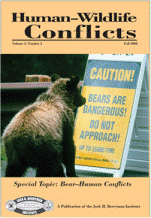Wildlife Damage Management, Internet Center for
Date of this Version
Spring 2009
Abstract
Feral hogs (Sus scrofa) are one of the most visible, troublesome, and interesting invasive species in North America. They have existed in North America probably since 1493 when Christopher Columbus purportedly released some hogs in the West Indies. Since then, hogs have spread across the continent and increased substantially in number. Today, feral hogs are both numerous and widespread throughout North America (Gipson et al. 1998, Adkins and Harveson 2007, Fogarty 2007, Mersinger and Silvy 2007), and published estimates suggested a U.S. population of between 1 and 2 million feral hogs (Mayer and Brisbin 1991).
If ever there existed a large, charismatic vertebrate in North America that could be labeled a pest, it is the feral hog. Aside from some recreational value for hunters, feral hogs in North America off er almost no benefit; yet, they cause many problems (Rollins et al. 2007). We know that hogs disrupt the ecosystem, compete with native wildlife, damage agricultural and timber resources, cause hazards to humans on roadways, and, via their role as a disease host, pose a health risk to both humans and livestock (Hartin et al. 2007, Kaller et al. 2007). Quite simply, there are not many nice things that one can say about feral hogs.
The management of feral hogs in many areas, particularly in Mississippi, is a great example of the complexity of managing human–wildlife conflicts. In his book, Resolving Human–Wildlife Conflicts, Conover (2001) suggested that all human–wildlife conflicts are comprised of 3 ingredients: an animal or animals causing damage, a resource or object being damaged, and a person or people being adversely aff ected. If one wishes to examine this model, the management of feral hogs in the Mississippi Alluvial Valley (MAV) provides an excellent case study.


Comments
Published in Human–Wildlife Conflicts 3(1):6–7, Spring 2009. Published and copyright by Jack H. Berryman Institute http://www.berrymaninstitute.org/journal/index.html